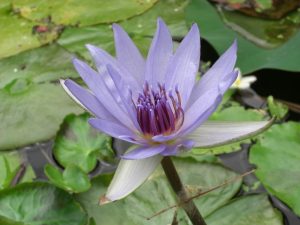Pond Plant Guide, Flowering Pond Plants
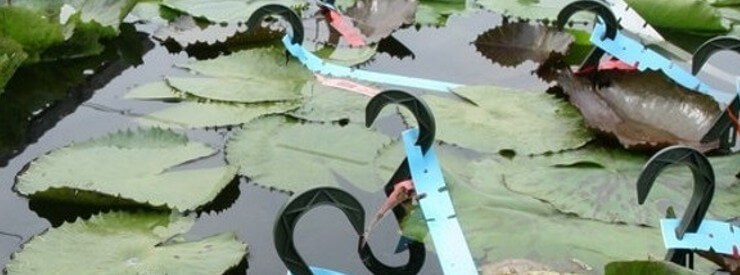
Pond plants not only give the pond a very aesthetic appearance, But There are also four main classifications of pond plant types:
- Floating pond plants
- Oxygenating or submerged pond plants
- Marginal pond plants and bog pond plants
- Deepwater pond plants
See how to pot and plant aquatic plants and water lilies here
Floating Pond Plants
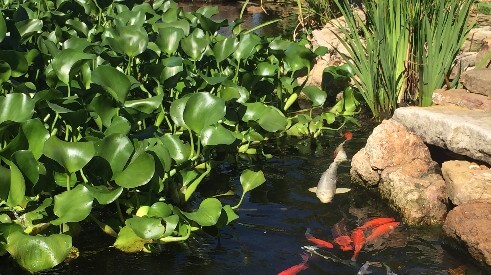
Floating pond plants, like the name implies, float on the pond surface and do not require any type of pond plant container, pond plant basket, or pond plant pot. Sometimes, floating pond plants can block or clog pond skimmer filters and/or pond pumps and therefore require a floating pond plant holder to keep them in place. Floating pond plant holders, or floating pond plant protectors keep koi from eating pond plants, too. When placed in floating pond plant protectors, floating plants tend to grow beautifully and tall adding perspective to the pond.
There are several varieties of pond plants: water hyacinths, water lettuce, frog bit, duckweed, and azolla to name a few. Most floating pond plants are tropical and therefore need to be taken out of the pond before winterizing the pond. In southern climates, floating pond plants will last all year.
Floating plants are excellent pond filters. Sometimes, in ponds that have effective pond filtration systems, floating plants do not fair well because there is not enough “food” in the water in the form of gunk, nitrate, etc. and must be fertilized using a fish and plant safe pond plant fertilizer. When fertilizing all pond plants, take care to use a fertilizer low in phosphate or use a pond plant fertilizer without any phosphates as to not encourage the growth of algae. If tablet fertilizers are preferred, use them in conjunction with a phosphate remover because fertilizing several lilies at once with fish and plant safe fertilizer tablets will cause an algae bloom.
When relying on floating plants to help filter the pond, remember the old rule of thumb: cover 1/2 of the surface with pond plants.
Oxygenating and Submerged Pond Plants
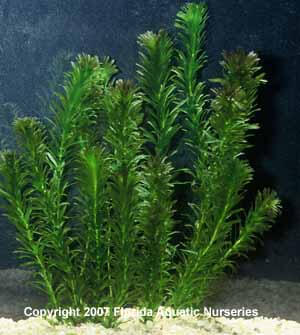
Oxygenating and submerged pond plants serve the purpose of filtering pond water and providing a place for koi and goldfish to lay eggs, as well as provide a place for fry (baby fish) to hide.
We typically handle anacharis and hornwart which are hardy oxygenating pond plants. Anacharis will flower if the pond is deep enough to allow the anacharis to grow large enough to flower.
To achieve maximum water quality with pond plants, we typically recommend 3-5 bundles of oxygenating plants for every 500 gallons of pond water.
Oxygenating pond plants are typically sold weighted. If not, they can be tucked under a stone and should be fully submerged.
Marginal Pond Plants
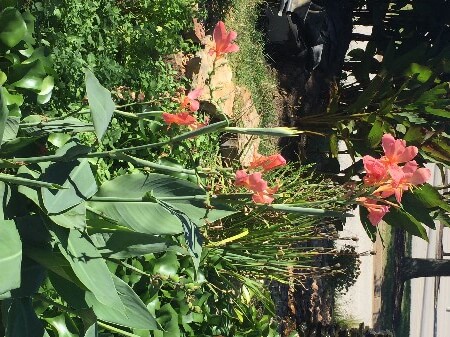
Marginal pond plants are the pond plants that grow in 2-12″ of pond water. They are perfect for ledges. Marginal pond plants that grow in very shallow water are often referred to as bog plants. Bog plants do not necessarily have to be in wthe ater, but, they need to constantly have wet roots. These are perfect for transitional areas or areas in the pond that are very shallow. Bog plants can be relied on as the sole filter of a garden pond.
There are hardy and tropical marginal pond plants. Most of the pretty pond plants like umbrella palms, papyrus, water cannas, and taro are tropical. Many marginal plants that are primarily foliage such as arrowhead, lizards tail, pickerel rush, bull rush, blue sedge, etc. are hardy.
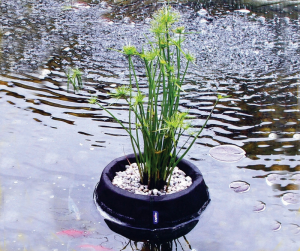
Marginal pond plants can be placed between rocks in shallow areas of the pond, in pockets of streams or splash pools in waterfalls, or potted in aquatic plant baskets and located on ledges around the inside edges of ponds. In areas where ledges are not level or uneven, mesh planting bags for pond plants can be used to prevent pond plants from falling over and into the pond. Many marginal plants, and even some annual and perennial plants like hostas and impatiens, do well in floating containers or floating planters.
Marginal and bog plants are suitable for container gardens, preformed ponds, and ponds constructed of EPDM pond liner.
Water Lilies and Water Lotus
There are two types of plants that classify as “deep water” pond plants with reference to garden ponds: water lilies and water lotus. Water lilies are typically easy to grow. Water lotus are easy to maintain once they are established. Water lilies are available in tropical and hardy varieties and water lotus are all generally hardy.
Although water lilies classify as a deep water aquatic pond plant, there are dwarf varieties available and are well suited for shallow areas, container gardens, and preformed ponds.
Water lilies do well in 2-3′ of water and even 5-6′ of water. They are very easy to add to any pond. When purchased at a pond supply store, they are often ready to be placed directly into the pond.
Hardy water lilies are typically available in varieties that flower yellow, pink, red, white, and different shades of bronze. Hardy water lilies flower all through the spring, summer, and early fall. Hardy water lilies can stay out all season long and are not affected by winter. Although there are articles promoting planting lilies in the gravel bottom of the pond, we recommend using aquatic plant baskets to keep water lilies from overtaking the pond. Water lilies should be thinned out every few years or they will overtake the pond and to regain control takes hours of back breaking work. All hardy water lilies bloom during the day.
Tropical water lilies are arguable much prettier than their hardy cousins. Varieties of tropical lilies are available in almost any color of the spectrum and the pad colors, shapes, and sizes differ, too. Tropical water lilies can be wintered over using the same method as a bulb. Tropical water lilies are available in varieties that bloom during the day and nighttime.

